Published
- 17 min read
Which IaaS Cloud Hosting Solution Is Best for Small and Growing Businesses?
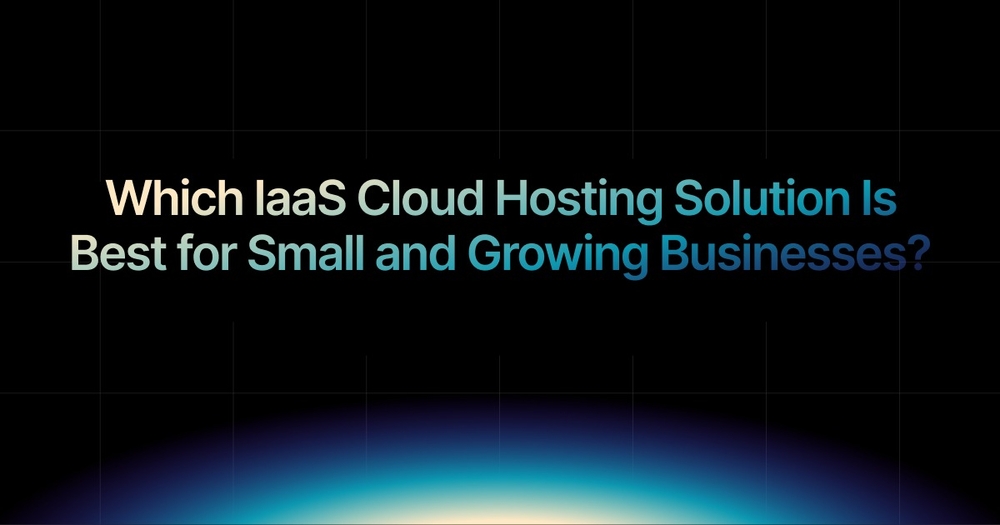
Introduction
For most small and growing businesses, choosing the right IaaS cloud hosting solution is one of the most important technology decisions they’ll ever make.
The cloud has become the backbone of modern business, powering everything from internal systems to customer-facing products, yet, for many teams, it still feels unnecessarily complex and expensive.
The challenge is simple to describe but hard to solve:
How do you find a cloud infrastructure that scales with your business without locking you into unpredictable costs or endless DevOps work?
Startups often begin with free credits or shared hosting, only to realise that what worked in the early days can’t handle growth, performance spikes, or global demand.
IaaS (Infrastructure as a Service) promises the flexibility to grow on your terms, giving businesses control over their compute, storage, and network resources without owning any hardware.
But not all IaaS platforms are created equal. Some prioritise enterprise features that small teams don’t need, while others make cost tracking nearly impossible once usage scales.
This guide breaks down what businesses should really look for in an IaaS cloud hosting solution, the key features, pitfalls to avoid, and smarter ways to build scalable infrastructure without draining your budget.
Along the way, we’ll explore what makes certain platforms better suited for small and growing businesses, and how modern automation-first models are reshaping how companies scale in the cloud.
What Is IaaS Cloud Hosting and Why Does It Matter for Small Businesses?
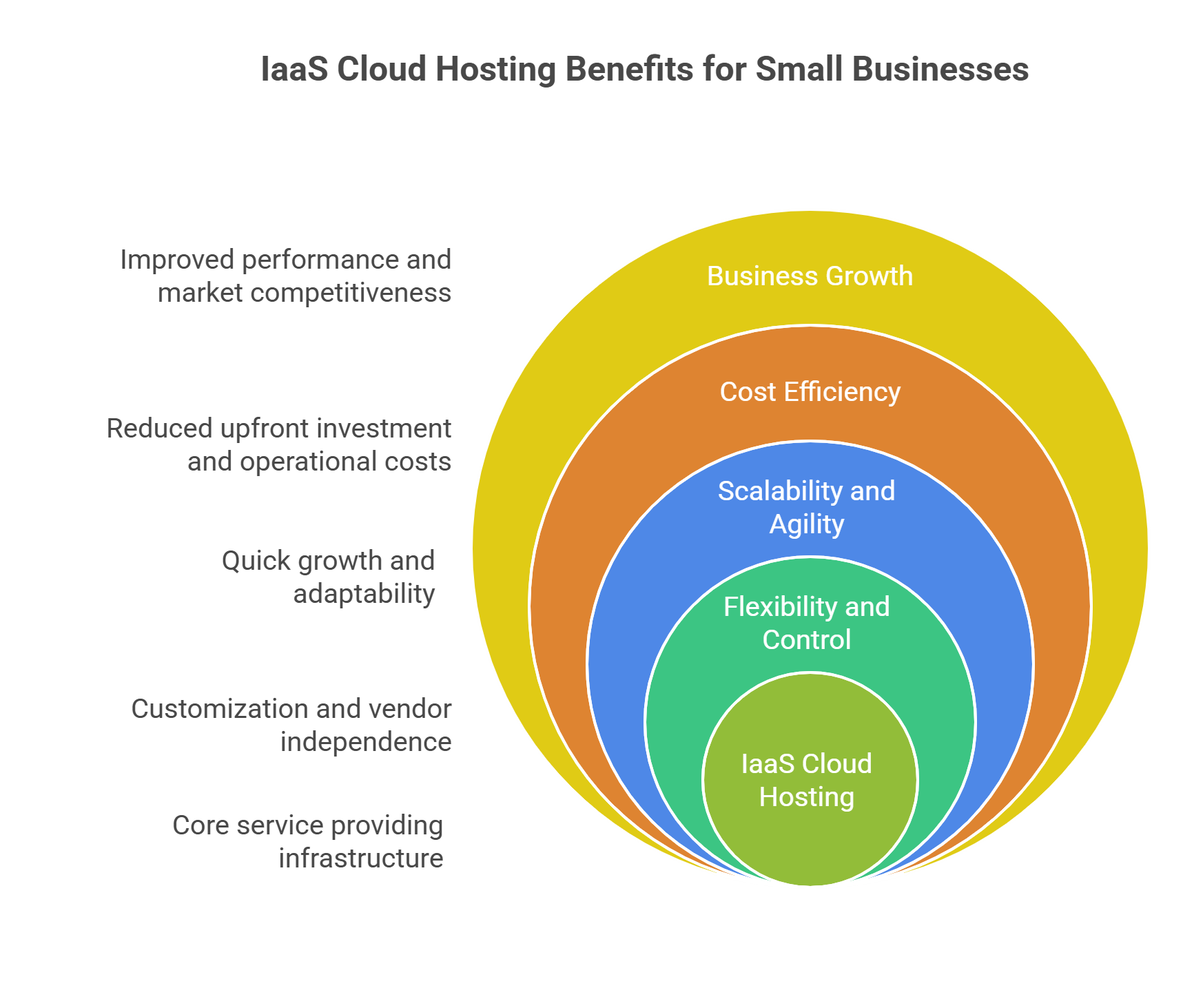 At its core, IaaS cloud hosting (Infrastructure as a Service) provides the foundational layer of cloud computing, virtual servers, storage, and networking that businesses can rent and manage on demand. Instead of buying hardware, setting up data centres, or maintaining physical servers, companies use an IaaS provider to host and scale their applications online.
At its core, IaaS cloud hosting (Infrastructure as a Service) provides the foundational layer of cloud computing, virtual servers, storage, and networking that businesses can rent and manage on demand. Instead of buying hardware, setting up data centres, or maintaining physical servers, companies use an IaaS provider to host and scale their applications online.
Think of it as the digital version of renting office space.
You get the infrastructure and utilities, but you decide how to use them. This flexibility gives small and growing businesses the power to scale quickly, stay agile, and compete with much larger players, all without heavy upfront investment.
What makes IaaS especially valuable for smaller teams is the balance it offers between control and convenience.
Unlike Platform as a Service (PaaS) or Software as a Service (SaaS), IaaS lets businesses choose their own tools, frameworks, and configurations. You get the flexibility to deploy applications exactly how you want, without being tied to a single vendor’s ecosystem.
For small businesses that often juggle limited budgets and tight deadlines, this control can be game-changing.
You can start with a single virtual machine and scale up as demand grows or scale down during slow periods to save money. This elasticity makes IaaS a natural fit for startups, agencies, and fast-moving digital businesses.
We covered a similar perspective in our guide on cloud computing for small businesses, where many early-stage teams saw how moving from traditional hosting to cloud infrastructure helped them reduce costs and improve reliability.
The same principles apply here: better performance, fewer limitations, and faster growth without long-term lock-ins.
In short, IaaS gives small businesses the infrastructure agility they need to launch fast, scale confidently, and stay cost-efficient, even as their workloads evolve.
The Core Needs of Small and Growing Businesses
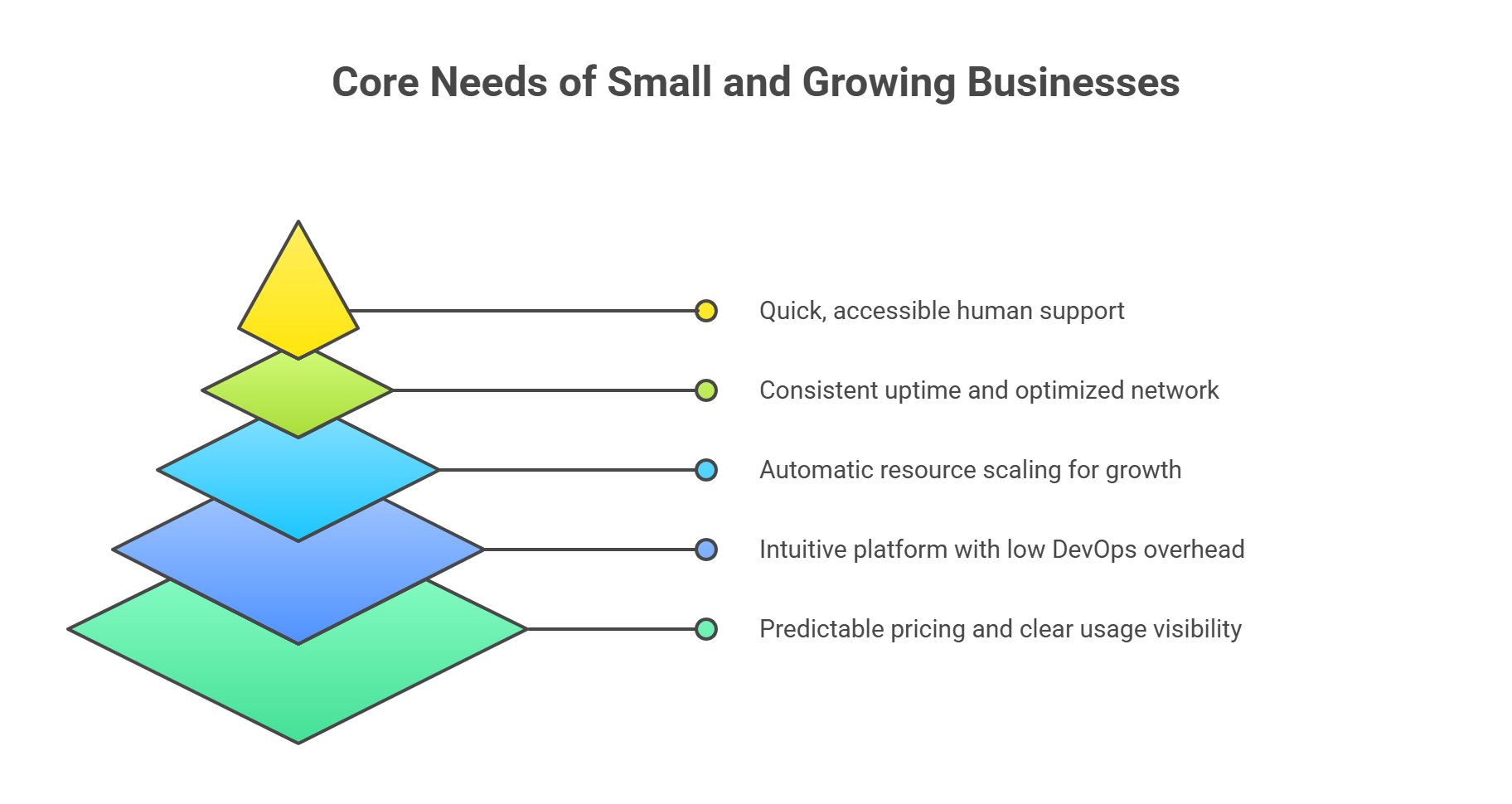 Before deciding which IaaS cloud hosting solution is best, it’s important to understand what small and growing businesses actually need from the cloud.
Before deciding which IaaS cloud hosting solution is best, it’s important to understand what small and growing businesses actually need from the cloud.
Most founders aren’t looking for advanced enterprise configurations. They want reliability, flexibility, and clarity without unnecessary complexity.
Here are the core factors that matter most when evaluating an IaaS provider:
1. Cost Efficiency and Transparency
For smaller businesses, every dollar counts. Predictable pricing and clear visibility into usage are essential. Traditional IaaS providers often charge separately for compute, bandwidth, and data transfer, making it hard to forecast bills. The ideal solution should make costs easy to track and eliminate surprise charges as usage scales.
2. Ease of Use and Low DevOps Overhead
Many growing businesses don’t have a dedicated DevOps team. They need a platform that’s intuitive, easy to deploy, and doesn’t require constant technical management. If getting an app online involves configuring servers, managing load balancers, and writing scaling scripts, it’s already too complex.
3. Scalability on Demand
Growth is unpredictable. One week, you might have steady traffic; the next, a viral campaign doubles it overnight. A great IaaS cloud hosting provider should make scaling resources automatic, not a manual process that slows teams down. Elasticity ensures performance stays smooth without overpaying for idle resources.
4. Consistent Performance and Uptime
Speed and reliability are the foundation of customer experience. Whether it’s a small e-commerce site or a SaaS platform, downtime directly impacts sales and trust. Businesses need infrastructure that offers strong SLAs, global data centre options, and optimised network performance.
5. Responsive, Human Support
Most small teams don’t have time to dig through documentation when something breaks. Quick, accessible support can make the difference between a five-minute fix and a five-hour outage. The best IaaS providers recognise that smaller customers still need enterprise-level care.
These five pillars form the baseline of what small and growing businesses should look for in an infrastructure provider.
Cloud hosting isn’t just about servers. It’s about reducing operational friction so teams can focus on building products and growing customers.
If you are looking for the top 10 IaaS Cloud Providers, read this article now
The Common Pitfalls of Popular IaaS Cloud Hosting Providers
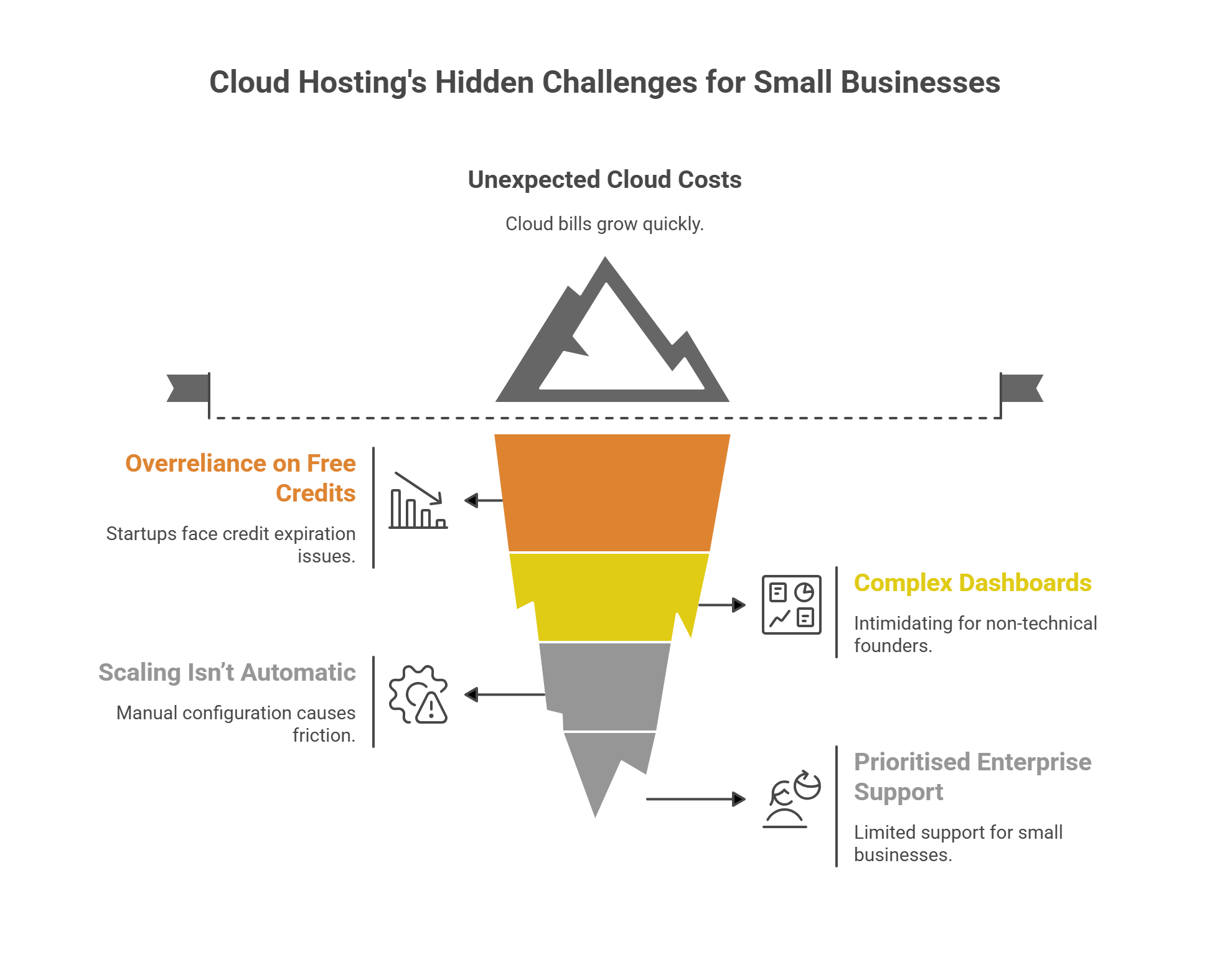 Even though IaaS cloud hosting is built to give businesses flexibility, many growing teams find themselves trapped in the same cycle, starting strong, scaling fast, and then hitting unexpected roadblocks that eat into both time and budgets.
Even though IaaS cloud hosting is built to give businesses flexibility, many growing teams find themselves trapped in the same cycle, starting strong, scaling fast, and then hitting unexpected roadblocks that eat into both time and budgets.
These challenges aren’t about the technology itself, but how traditional cloud providers structure their services.
Here are some of the most common pitfalls small and growing businesses face:
1. Hidden and Unpredictable Costs
One of the biggest frustrations for small businesses is discovering how quickly cloud bills grow. While initial pricing looks affordable, hidden costs like data egress, storage IOPS, and API requests can quickly multiply. A CloudZero report found that nearly 70% of companies overspend on cloud services due to poor cost visibility. For small businesses, that kind of waste can completely derail growth plans.
2. Overreliance on Free Credits
Many cloud providers attract startups with generous credit programs like AWS Activate or GCP Startup Credits. But once those credits expire, the reality hits hard. Monthly bills rise dramatically, and because many teams didn’t budget for full-cost usage, they’re forced to scale back operations or look for cheaper alternatives. We explored this “credit cliff” problem in our article on cloud for startups, where many early-stage companies found their growth momentum slowed down just when demand was taking off.
3. Complex Dashboards and Steep Learning Curves
Traditional IaaS platforms often assume users have in-house DevOps expertise. Their dashboards and documentation can be intimidating for non-technical founders or lean teams. Managing instances, storage, scaling, and network policies becomes a full-time job, taking valuable focus away from product development.
4. Scaling Isn’t Always as “Automatic” as Promised
While most cloud providers advertise auto-scaling, the setup often involves configuring metrics, load balancers, and scaling rules manually. This creates friction at exactly the wrong time, during rapid growth or traffic spikes. For small teams, these extra layers of management can lead to slowdowns or even downtime.
5. Support That Prioritises Enterprise Clients
Many IaaS providers prioritise large enterprise customers, leaving small and mid-tier businesses with limited or delayed support. When something breaks, small teams are often directed to long-form documentation or support queues that take hours to respond.
These pitfalls don’t mean cloud infrastructure is the wrong path. They simply highlight how traditional IaaS models aren’t designed with smaller, fast-moving businesses in mind.
What small businesses need isn’t more configuration power. It’s simpler automation, cost clarity, and peace of mind while scaling.
The Smarter Approach: Choose Infrastructure That Grows With You
Most small and growing businesses don’t need complicated infrastructure. They need cloud systems that adapt as they grow.
The best IaaS cloud hosting solution isn’t the one with the longest feature list. It’s the one that scales quietly, optimises costs automatically, and gives founders time to focus on their product instead of dashboards.
That’s where Kuberns represents a smarter approach to IaaS Alternatives.
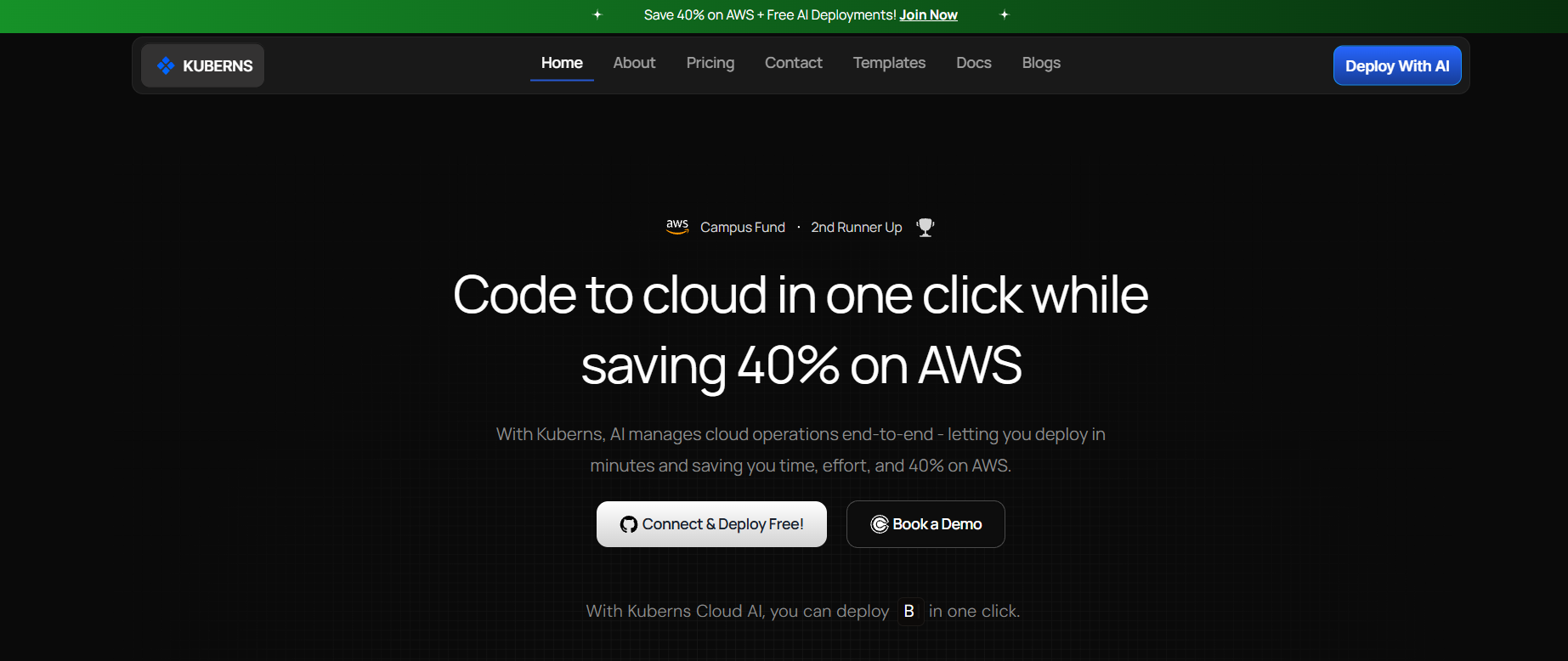
It’s built for businesses that want cloud-level control without the burden of managing every detail. Instead of spending hours configuring servers, scaling rules, and pipelines, teams on Kuberns can deploy their applications in minutes and let the platform handle the rest through automation and AI optimisation.
Kuberns brings together three things that truly matter to fast-growing businesses:
- Automation-first scaling: The platform automatically adjusts compute and storage based on traffic and performance, ensuring you never overpay or underperform.
- Transparent and predictable pricing: Costs stay consistent and easy to track, without hidden data transfer or usage-based surprises.
- AI-powered efficiency: Workloads are continuously optimised for performance and cost, helping businesses save up to 40% on AWS infrastructure.
For small teams or digital agencies managing multiple projects, this difference is transformative.
Instead of worrying about uptime or scaling policies, they can focus on building and growing their products while the infrastructure quietly adapts in the background.
How Small Businesses Can Make the Transition Smoothly?
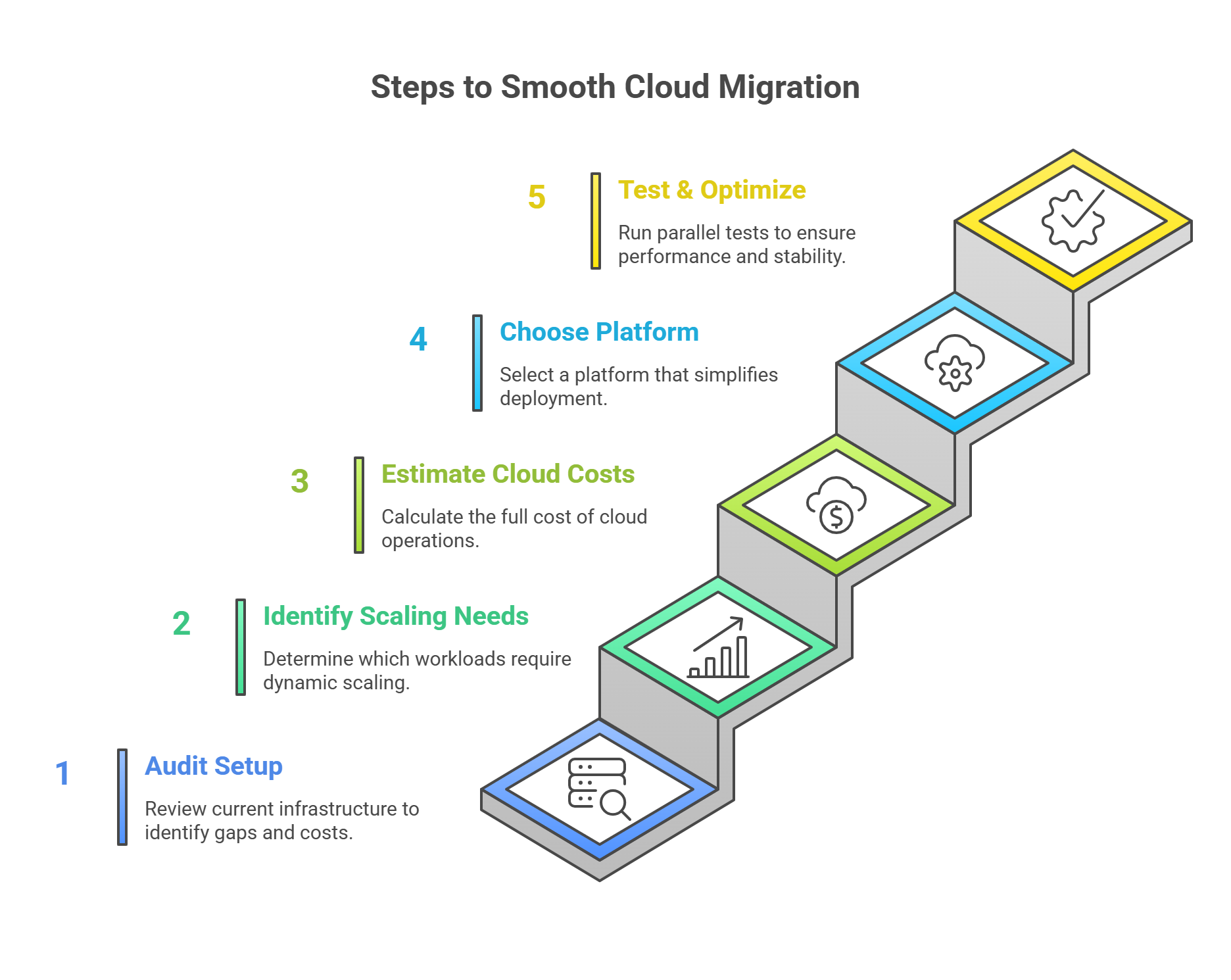 Switching from traditional hosting or manually managed IaaS setups to a smarter, automated infrastructure can seem intimidating at first.
Switching from traditional hosting or manually managed IaaS setups to a smarter, automated infrastructure can seem intimidating at first.
But in reality, it doesn’t have to be. For most small and growing businesses, the challenge isn’t whether to move, it’s how to move efficiently without interrupting daily operations.
The key lies in planning your transition step by step.
Whether you’re running a SaaS product, an agency handling client deployments, or an e-commerce platform scaling traffic, a smooth migration follows the same foundational process.
1. Audit Your Existing Setup
Start by reviewing your current infrastructure. What’s hosted where, how resources are used, and which parts are driving the most cost. Understanding the gaps in performance and spending helps identify where automation and optimisation will have the biggest impact.
2. Identify What Needs to Scale
Not every part of your system requires cloud elasticity. Determine which workloads (like APIs, dashboards, or data services) need to scale dynamically, and which can stay fixed. This clarity prevents unnecessary expenses later.
3. Estimate True Cloud Costs
Before migrating, calculate the full cost of running workloads, including data transfer, storage, and compute. Many businesses underestimate this step and face a “cost shock” post-launch. Platforms that offer cost visibility and optimisation features help avoid this.
4. Choose a Platform That Simplifies Deployment
Once your requirements are clear, focus on ease of deployment. Modern platforms like Kuberns allow businesses to connect their code repositories, deploy applications in one click, and let the system handle scaling and monitoring automatically. This removes the DevOps bottleneck that small teams often struggle with.
5. Test, Measure, and Optimise
Run your infrastructure in parallel for a short period, old and new, to measure performance, stability, and cost differences. This testing phase builds confidence and minimises disruption during full migration.
Migrating to a smarter cloud infrastructure isn’t just a technical upgrade. It’s a strategic decision.
For small businesses, the goal should be to gain speed, clarity, and scalability without adding operational complexity. Kuberns make that possible by combining automation, cost control, and reliability into a single environment.
Real-World Perspective
Every growing business eventually reaches the same turning point: the moment when manual infrastructure management starts slowing everything down. It’s the stage where adding new users, features, or regions takes longer than it should, and cloud bills keep rising despite all the effort to optimise them.
That’s where smarter infrastructure choices redefine how small teams scale.
Here are a few examples of how modern IaaS cloud hosting helps businesses grow faster without breaking their budgets:
1. The SaaS Startup That Stopped Chasing Credits
A two-person SaaS team launched their app using free credits from a major cloud provider. Everything looked fine until the credits ran out and their monthly bill jumped from ₹0 to over ₹80,000.
Instead of cutting back features, they switched to an automation-first platform, Kuberns. Their workloads were optimised in real time, scaling automatically during traffic surges and idling down when usage dropped. Within a month, they reduced cloud costs by nearly 40% and focused entirely on shipping updates instead of tweaking servers.
2. The Digital Agency Managing Multiple Clients
A small web agency handled hosting for over a dozen client projects, each running on a different cloud setup. The complexity was painful. Constant context switching, manual updates, and billing confusion. Moving to a single IaaS platform that supported one-click deployments and transparent billing made management seamless.
They could monitor all client apps from one dashboard, respond faster to requests, and deliver projects 3x quicker than before.
3. The E-commerce Brand Preparing for Holiday Traffic
An online retailer saw massive seasonal spikes every December, often struggling to stay online during peak sales hours. With traditional hosting, scaling up took days of preparation.
By shifting to a cloud platform that auto-scales and optimises workloads, they maintained consistent performance even during 10x traffic spikes, without overspending the rest of the year.
Each of these businesses had different needs, but the outcome was the same: better performance, lower costs, and more focus on growth.
The difference wasn’t in how much cloud power they bought. It was in choosing infrastructure that automates the hard parts.
As we’ve seen throughout this guide, platforms that simplify scaling and provide cost transparency help small teams operate like enterprises, without the overhead. And that’s exactly what today’s businesses need: infrastructure that adapts, optimises, and grows with them.
Choose Cloud That Works for You, Not Against You
The right IaaS cloud hosting platform can determine how quickly you launch, how well you scale, and how efficiently you spend.
But too often, businesses end up fighting their own infrastructure, juggling hidden costs, manual scaling, and tools that add complexity instead of removing it.
It doesn’t have to be that way. Today’s smarter cloud platforms are designed to do more with less, giving teams automation, visibility, and performance without demanding heavy technical expertise.
The focus should be on building your product and serving customers, not configuring infrastructure or watching bills grow.
That’s exactly what Kuberns does.
It’s built for teams that want the flexibility of IaaS with the simplicity of automation. With AI-driven cost optimisation, one-click deployments, and AWS-backed reliability, Kuberns helps businesses scale confidently while saving up to 40% on cloud costs.
If your goal is to scale faster, spend smarter, and simplify infrastructure management, it’s time to choose a cloud that works with you, not against you.

People Also Ask
1. What is IaaS cloud hosting in simple terms?
IaaS (Infrastructure as a Service) is a type of cloud hosting where you rent virtual servers, storage, and networking from a provider instead of maintaining your own hardware. It gives businesses full control over their infrastructure while only paying for what they use.
2. Why is IaaS cloud hosting important for small and growing businesses?
For smaller teams, IaaS cloud hosting offers flexibility, scalability, and cost efficiency without large upfront investments. It lets businesses launch faster, handle traffic growth easily, and manage infrastructure from anywhere. You can read more about these benefits in our post on cloud computing for small businesses.
3. How does IaaS differ from traditional hosting?
Traditional hosting provides fixed resources on a shared or dedicated server. In contrast, IaaS allows businesses to scale resources up or down instantly, automate deployments, and pay only for what they use. This flexibility makes IaaS ideal for fast-growing startups and dynamic workloads.
4. Which IaaS cloud hosting solution is best for small businesses?
The best solution depends on your stage and goals. For smaller teams, automation-first platforms like Kuberns simplify scaling, reduce DevOps work, and cut infrastructure costs by up to 40%.
5. How can businesses reduce costs on IaaS cloud hosting?
Start by optimising resource usage, automating scaling, and tracking hidden expenses like data transfer or storage IOPS. Using AI-based optimisation tools or platforms that include built-in cost management, such as Kuberns, helps businesses stay efficient and avoid overspending.
6. Is IaaS hosting suitable for startups without DevOps teams?
Yes. Many modern IaaS platforms now include automation and managed scaling features, which eliminate the need for dedicated DevOps teams. Startups can deploy directly from their code repository, and the platform handles infrastructure setup, monitoring, and scaling automatically. This is exactly how Kuberns helps founders scale without technical overhead.